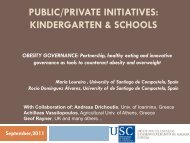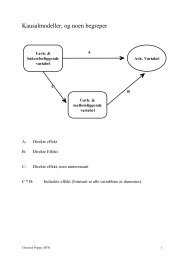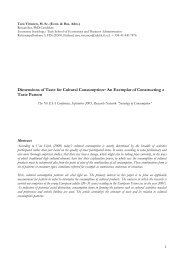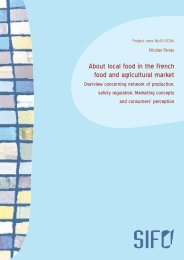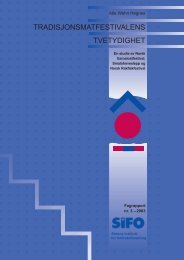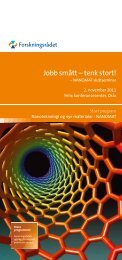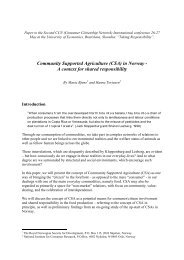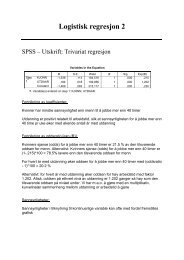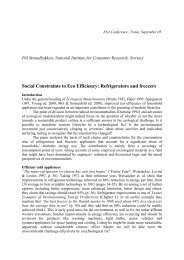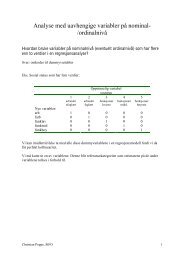Wool in Life Cycle Assessments and Design Tools - SIFO
Wool in Life Cycle Assessments and Design Tools - SIFO
Wool in Life Cycle Assessments and Design Tools - SIFO
- No tags were found...
Create successful ePaper yourself
Turn your PDF publications into a flip-book with our unique Google optimized e-Paper software.
entire LCA? Is it a question of over-simplify<strong>in</strong>g <strong>in</strong> order to please the consumer? Or is this a case ofwolf <strong>in</strong> sheep’s cloth<strong>in</strong>g, try<strong>in</strong>g to manipulate the results to someone’s advantage?“When possible, world average data have been used. However the rank<strong>in</strong>gs should be ratedapproximate, some data are regional specific <strong>and</strong> would not necessarily be applicable if sourcedfrom another region or supply cha<strong>in</strong> us<strong>in</strong>g different techniques (e.g. ra<strong>in</strong> fed l<strong>and</strong> versus irrigatedl<strong>and</strong>)Energy usage <strong>and</strong> GHG emissions could vary widely dependent on each farm <strong>and</strong> energy typeused”. (MadeBy <strong>in</strong> EcoTextile News 2010)6. DEFRA StudyDEFRA Study : The role <strong>and</strong> bus<strong>in</strong>ess case for exist<strong>in</strong>g <strong>and</strong> emerg<strong>in</strong>g fibres <strong>in</strong> susta<strong>in</strong>able cloth<strong>in</strong>g, 2009The fiber comparison <strong>in</strong> the DEFRA Study shows more or less the same as the MadeBy assessment.This study is based upon broad literature studies of LCA of fibers <strong>and</strong> textilesLiterature <strong>and</strong> other sources of <strong>in</strong>formation were collated to identify the environmental impacts ofeach fiber supply cha<strong>in</strong>, from raw material production to factory gate for the above fibers. Data onenergy use (<strong>in</strong>direct <strong>and</strong> direct) <strong>and</strong> water use for each phase of the cha<strong>in</strong> was collated whereavailable. Information on other impacts (greenhouse gas emissions, waste water emissions) wasmuch more limited. Other impacts, such as l<strong>and</strong> use dem<strong>and</strong>s for non-synthetic fibers, werecalculated from the available data.Any LCA on fiber up to sp<strong>in</strong>n<strong>in</strong>g will reach the same conclusion <strong>and</strong> po<strong>in</strong>t to the same “bad guys”;Cotton will always be the water-consumer, wool the l<strong>and</strong>-consumer <strong>and</strong> polyester the nonrenewablesconsumer.Compar<strong>in</strong>g productsLCA is often used to compare products with each other. Therefore it is necessary to consider thewhole life cycle, from cradle to grave, or cradle, <strong>in</strong> order to get a real picture of impacts <strong>and</strong> the realcomparisons of products <strong>and</strong> services. An analysis that looks only at one or a few stages can be doneas well, but must be clearly communicated <strong>and</strong> treated as such.The European Environmental Agency 7 recommends that LCAs are not used to claim a product orservice is environmentally friendly or superior to another. It is possible to claim that us<strong>in</strong>g a specifiedset of criteria, one product is better than another <strong>in</strong> certa<strong>in</strong> aspects of its performance. However ifmak<strong>in</strong>g such claims it is very important that accurate data <strong>and</strong> unbiased <strong>in</strong>formation is used, theassessment has been peer reviewed, <strong>and</strong> not to over-claim.7 European Environmental Agency, EEA, 19979



